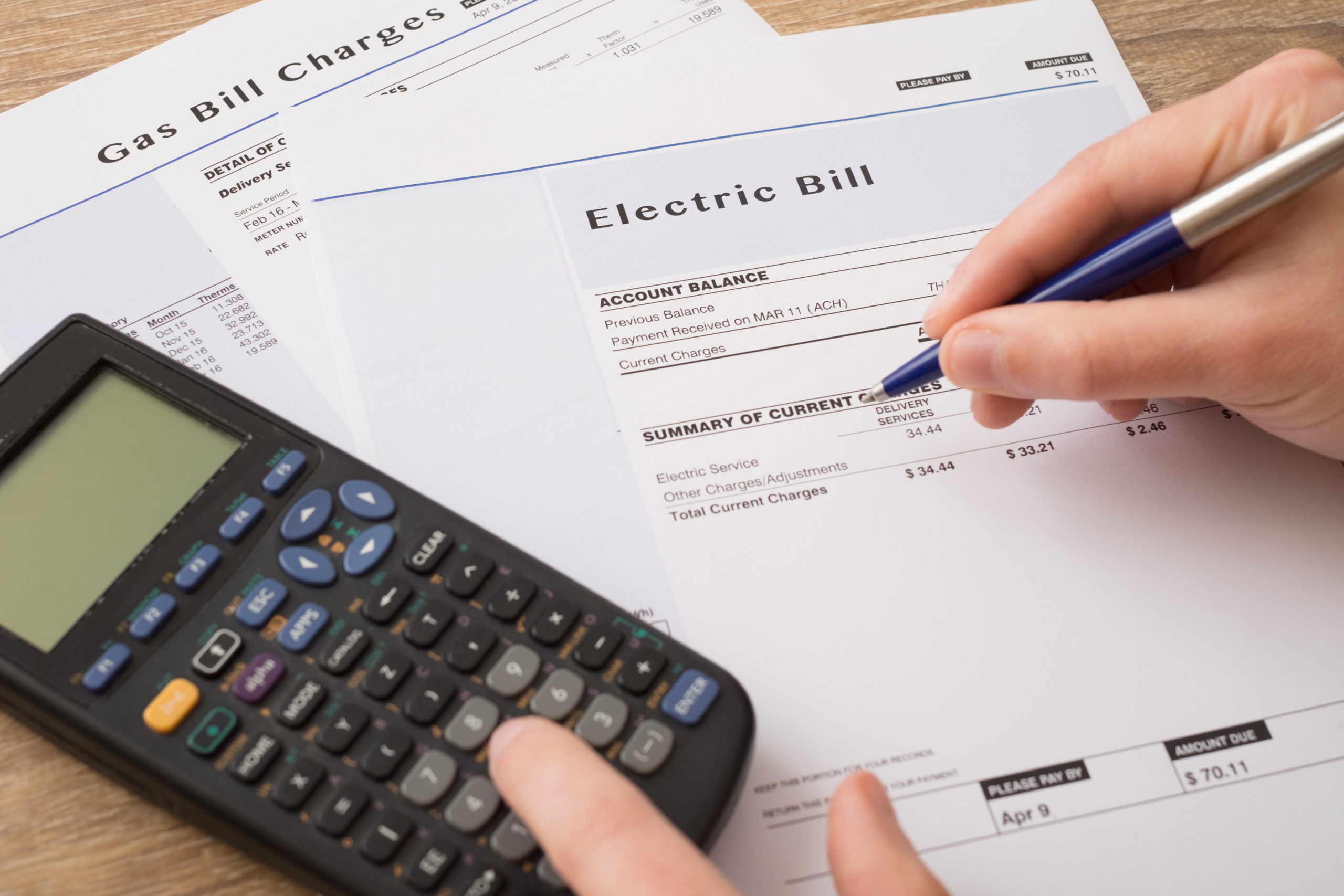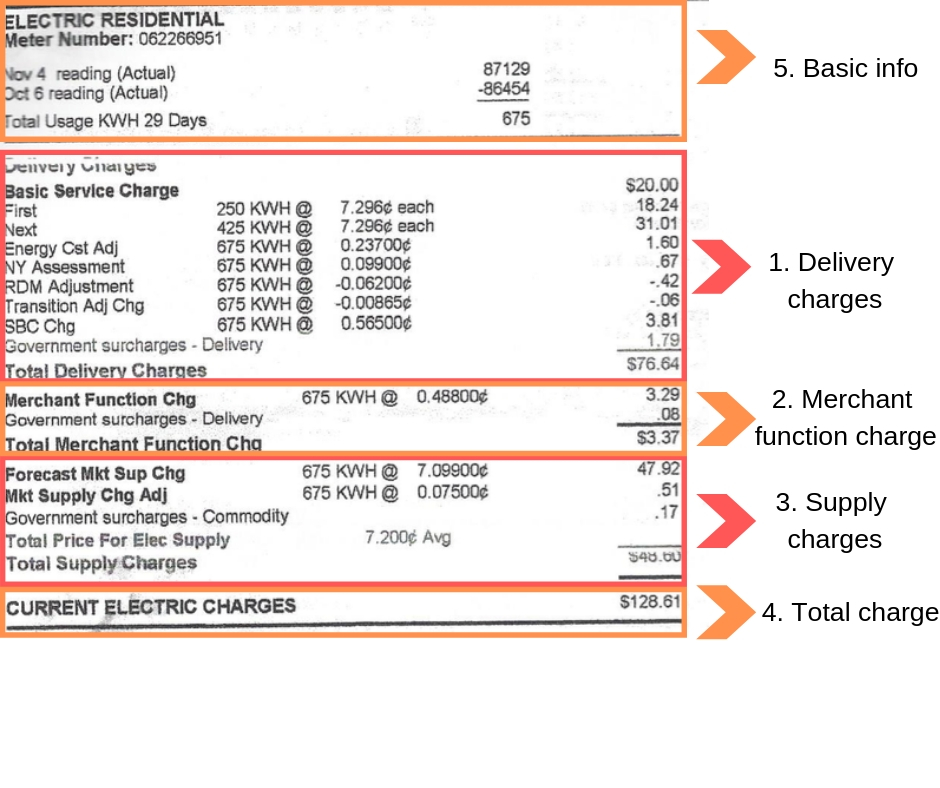We break down an Orange & Rockland electric bill line by line and let you know where you can save.
An electric bill might seem like one of the most boring pieces of paper in the world.
When I open my electric bill, I see abbreviations that exist nowhere else in my life, like “RDM Adjustment” and “SBC Chg.” Ugh. After a squint of the eyes, a roll of the sleeves, a dutiful nod of the head, and a self-assured “Yep, makes perfect sense!” I pay my bill.
Meanwhile, inside, I’m actually thinking:
When motivation to understand where so much of my money is going builds up, I’ll either examine the definitions on the back of my bill or head to Google for answers. Either way, I face energy industry terms that do little to clear things up. Eventually I realize this isn’t exactly how I wanted to spend my evening, and I relent.
That’s why we’re writing this little piece: to demystify all the terms and concepts that make paying for energy uncomfortable and confusing. And if you’re lucky, you might even discover some great ways you can pay less.
Table of Contents
An Orange & Rockland Electric Bill
Orange & Rockland has some of the least predictable energy prices in the country. While most energy suppliers’ “price to compare,” or average price per kWh of electricity, stays fairly consistent, Orange & Rockland’s price to compare jumps around quite a lot from month to month. In 2018, prices fell as low as $.067/kWh in May and reached as high as $.112/kWh in February–a difference of about $40 for the average American household, even without changing energy use.
In theory, these flexible adjustments help the utility stay on top of costs and avoid billing customers incorrectly. Unfortunately, they also make it hard to plan for next month’s bill. That makes it all the more essential to understand what’s going on with your charges and how your dollars are being spent.
Orange & Rockland customers’ electric residential charges can be split into a few different parts. First of all, yes, it’s odd that the top section is labeled #5. It makes sense to discuss that part last. It still looks odd in the picture, but we hope our readers can get past that.
We’ll begin with delivery charges, move onto the merchant function charge, supply charges, and total charge, and end with some advice about how to use the basic information at the top of your bill to your advantage.
1. Delivery Charges
This section represents the cost of getting electricity down all the transmission lines, through the distribution stations, and into your home. Understandably, delivery charges are also called “distribution and transmission charges” in some places. Maintaining the infrastructure needed to get electricity to millions of people reliably comes with particular costs–including the following:
Basic Service Charge: Every customer of Orange & Rockland gets a basic service charge of $20, regardless of their energy habits. It accounts for “basic service” tasks, like giving you a meter, sending someone out to read it, and billing you each month. As long as you’ get electricity from the grid, you’re not escaping this one.
First: The first 250kWh of your energy use are billed at a set rate. If you used 250kWh or less, congratulations! You’ve used very little electricity, and the next item won’t apply to you.
Next: If you used more than 250kWh of energy, a line that says “Next” will count up the electricity your household used beyond that point. You pay less per kWh of this extra energy, because delivering energy to your house comes with fixed costs (building and maintaining power lines, etc.) that don’t rise with extra energy use. Still, don’t go crazy; it’s always cheapest to use less energy!
As a brief note:the unit used here is kWh, or killowatt-hours of electricity. This is a measure of the amount of kilowatts your household used times the amount of time it used those kilowatts for. So if you run a 500-watt laundry machine for two hours, you’ve used 1,000 watt-hours, or 1 kilowatt-hour, of electricity.
Energy Cost Adjustment: O&R, like just about all utilities, gets much of its power by buying it from suppliers. It sets its rates based on how expensive it thinks that fuel will be, but those estimates aren’t perfect. When the utility actually makes the purchase, they calculate the difference between their projection and the actual costs of fuel. When the price of energy is high, you’ll get charged extra to help the utility cover costs. When the price is low, you might actually see money returned to you, which can be a nice little surprise.
NY Assessment: This is a bit of a wonky one. If you check on the back of your bill or on Orange & Rockland’s website, you’ll find that the NY assessment “recovers fees imposed by the state as authorized under section 18-a of the public service law.” That doesn’t exactly reveal what you’re paying for. If you want to read section 18-a of the public service law, you can find it here.
If you want the basic gist, here it is: the New York Department of Public Service takes on costs for regulating all New York utilities. It has to investigate utilities’ power lines, assess their power plants, and so on. Those costs in part get passed on to customers in this part of their bill.
RDM Adjustment: Utilities are regulated so that they don’t profit from delivering energy to their customers. That’s what keeps monopolies honest; otherwise they’d be incentivized to raise rates constantly with no consequences.
When Orange and Rockland over-collects on delivery charges, it returns the profits to customers with a “revenue decoupling mechanism” adjustment, or RDM for short. This comes up as a refund on customers’ next bill. When the utility undercollects, it charges extra in the RDM adjustment to level things out.
Transition Adj Charge: Customers in deregulated energy markets like New York get a transition charge to help the utility pay down “stranded costs” from the transition to deregulation. In other words, even though the market was deregulated with a swish of a pen, the utility didn’t exactly have all its infrastructure prepared for that scenario, so it ended up with unnecessary plants and equipment that take years to shut down. The transition charge helps Orange and Rockland cover those costs until its regulators decide the utility has recovered.
SBC Charge: A system benefits charge (SBC) is a surcharge with two main purposes. It goes toward meeting the state’s bold, nation-leading clean energy targets through projects like utility-led solar gardens. It also funds programs to research and improve energy efficiency and provide low-income assistance to help New Yorkers pay for their energy.
Not benefitting from any of these initiatives yet? Here are some good ways to get involved in energy saving programs through O&R. A couple highlights:
- Sign up for a smart thermostat program that gives O&R the power to make brief, small adjustments to your household temperature. You hold on to control of your thermostat–and get $85 for joining.
- Opt to pay less for electricity during off-peak hours (when people are using the least energy) and more during peak hours. Adjusting your schedule to run appliances during off-peak hours can save you quite a bit.
Government Surcharges – Delivery: Taxes, both on the state and local level, apply to energy delivery just like any other purchase or delivery. Total Delivery Charges: Add up everything above the line and you have your total delivery charges.
2. Merchant function charge
This one covers the administrative costs (staff, equipment, etc.) of buying electricity for customers. If you go with an alternate supplier, you won’t get this charge, because the utility won’t be procuring energy for you anymore. It’s sort of an awkward child, because it doesn’t get categorized under delivery or supply charges.
3. Supply Charges
From here on down, costs come from energy supply. Whereas delivery charges account for the cost of bringing electricity into your home, supply charges cover the cost of the actual electricity itself–generating it and, when utilities buy it from another source, purchasing it.
Forecast Market Supply Charge: When utilities buy electricity, they forecast what they think they’re going to pay for it. Why do they need to forecast it instead of just billing people directly for its price? Because meter reading isn’t always aligned with the actual purchasing of electricity, so they have to bill folks before they know the price for sure.
Market Supply Charge Adjustment: When the actual price comes in, the adjustment makes up for the difference. If they guessed too low, you’ll get charged extra to help the utility cover costs. If they guessed high, you might actually see money returned to you, which can be a nice little surprise.
Government Surcharges – Commodity: The actual energy is taxed separately from its delivery, because they’re really two different products/services.
Total Price For Electricity Supply: Divide total supply charges by total kwh of energy used to get the cost per kwh of electricity–aka your electricity price.
Total Supply Charges: The total cost of your electricity supply, with government surcharges and market adjustments factored in.
4. Total Charge
Delivery charges + merchant function charge + supply charges = your current electric charge, aka the total charge. Phew!
5. Basic info
If you feel like you got charged more than expected on your electric bill, here are three steps you can take to understand why, using the basic information at the top of your electric charges.
- Check out your total kwh of consumption. Did you use more energy than usual this month? If you did, consider a few handy strategies to bring down your energy use.
- Look at the dates of your readings. If they’re a few days further apart than usual, those extra days will be reflected in a more expensive bill. The next bill, or at least one down the line, will be cheaper as a result of a shorter billing cycle.
- Note whether your readings, both the last one and the present one, are labeled “Actual” or “Estimated.” An actual reading is based on a reading of your meter, while an estimated reading is a guess based on your usage in the past. Estimated readings aren’t completely accurate, so they may overcharge you. That charge will get made up for down the line with a lower bill, but still: this month’s payment will be unpleasant.
If you got charged less than you expected on your electric bill, well…we recommend keeping that on the downlow. We won’t tell anyone. Just kidding! Mostly. If your bill is surprisingly low, we recommend you follow the same steps from above. If you just used less energy this month, keep up the good work! Consider how you can reproduce your sustainable habits from this month in the future. A low bill could also come from a shorter billing period or an estimated reading that underbilled you. In either of these last two cases, be on the lookout for a larger bill next time around that makes up for the difference.
Still Have Questions On Your Bill?
- Comment below and I’ll get the answer for you right here!
- Visit Orange & Rockland’s website to find answers to frequently asked questions.
- Didn’t find the answer? You can get in touch with the utility here (or through the contact info at the top of your bill, shown above) to resolve issues.








Thanks for sharing all of your experiences!
Really informative, thanks for sharing this!
thank you so much for sharing this and keep it up, thanks for this post
I got a DLM Surcharge on my most recent bill. Searching the ORU site for this term returned no hits. It was not mentioned in the "explanation" section of the bill. I contacted some of my friends who are O&R customers and it was not on their bill. What is this
Hi there, thanks for reaching out. I'm actually not familiar with this charge myself (hence why it doesn't appear in our article), but I did some research and most hits seems to be returning that dynamic load management relates generally to the ability to charge electric vehicles. Do you have an EV, perhaps?